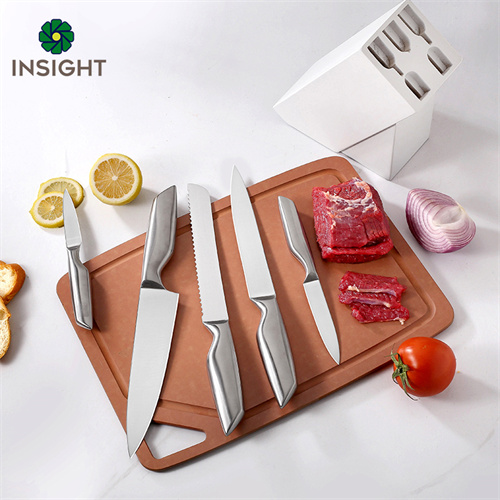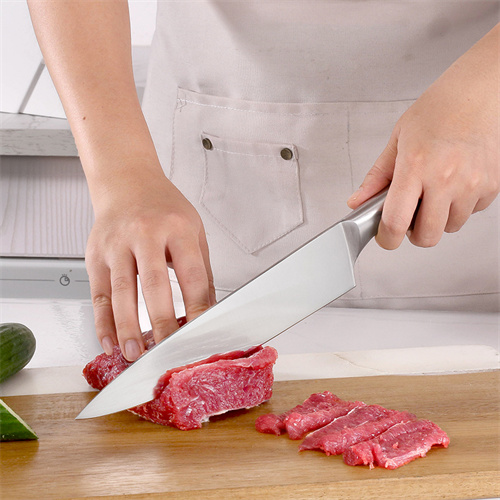

Views: 600 Author: sales@insightknife.com.cn Publish Time: 2025-01-20 Origin: Site








Content Menu
● Understanding Knife Sharpening
● The Risks of Over-Sharpening
>> Altering the Blade Geometry
>> Uneven Edge
>> Visible Wear
● Best Practices for Knife Sharpening
● Frequently Asked Questions regarding Knife Sharpener
>> 1. What is the best way to sharpen a knife?
>> 2. How often should I sharpen my knives?
>> 3. Can I ruin a knife by using an electric sharpener?
>> 4. What are the signs that my knife needs sharpening?
>> 5. Is it possible to over-sharpen a knife?
Sharpening a knife is an essential part of maintaining its performance and longevity. However, many knife enthusiasts and professionals often wonder if it is possible to ruin a knife by sharpening it too much. This article delves into the intricacies of knife sharpening, the potential risks involved, and best practices to ensure your knives remain in optimal condition.
Knife sharpening is the process of removing material from the blade to create a new edge. This is necessary because, over time, the edge of a knife can become dull due to regular use. A sharp knife not only enhances cutting efficiency but also improves safety, as a dull knife can slip and cause accidents. The act of sharpening restores the blade's ability to slice through food with ease, making meal preparation more enjoyable and efficient. Additionally, a well-maintained knife can reduce the effort required during cutting tasks, allowing for a smoother cooking experience.
There are various types of knife sharpeners available, each with its own advantages and disadvantages. Understanding these can help you choose the right tool for your needs. Selecting the appropriate sharpener is crucial, as it can significantly impact the longevity and performance of your knives.
Manual sharpeners, such as whetstones and honing rods, require skill and practice. They allow for precise control over the sharpening angle and pressure, which can help maintain the integrity of the blade. Whetstones, for instance, come in different grits, allowing users to choose the level of abrasiveness needed for their specific knife. This versatility makes them a favorite among professional chefs and serious home cooks alike. Honing rods, on the other hand, are excellent for maintaining an edge between sharpenings, helping to realign the blade without removing much material.

Electric sharpeners are convenient and can quickly sharpen a knife. However, they often remove more material than necessary, which can lead to over-sharpening if not used carefully. These devices typically have preset angles, making them user-friendly for those who may not have experience with manual sharpening. However, the speed and efficiency of electric sharpeners can be a double-edged sword, as they may inadvertently compromise the blade's structure if used too frequently or aggressively.
These are user-friendly and designed for quick sharpening. However, they can be harsh on blades and may cause damage if used improperly. Pull-through sharpeners often have fixed angles, which can be beneficial for beginners. Still, they may not provide the same level of precision as manual methods. Users should be cautious, as relying solely on these tools can lead to a decline in the knife's overall quality over time.
Every time a knife is sharpened, a small amount of material is removed from the blade. Over time, excessive sharpening can significantly reduce the blade's thickness, leading to a weaker structure. This can result in a knife that is more prone to chipping or breaking. The cumulative effect of repeated sharpening can alter the knife's balance and handling, making it less comfortable to use. Additionally, a thinner blade may not perform as well in tasks that require strength, such as cutting through tough meats or dense vegetables.
Sharpening a knife too frequently can alter its geometry. The angle of the edge may change, which can affect cutting performance. A knife that is sharpened too much may lose its intended design, making it less effective for its specific purpose. For example, a chef's knife is typically designed with a specific angle to facilitate precise cuts. If this angle is altered through over-sharpening, the knife may struggle to perform tasks it was originally intended for, leading to frustration in the kitchen.
When sharpening, it is possible to create a wire edge, which is a thin, fragile edge that can easily bend or break. If a knife is sharpened too much, this wire edge can become pronounced, leading to a dull blade despite the appearance of sharpness. This phenomenon occurs when the sharpening process creates a thin layer of metal that is not properly aligned with the blade's edge. As a result, the knife may feel sharp initially but will quickly lose its effectiveness during use.
If you notice that your knife feels dull even after sharpening, it may be a sign that you have over-sharpened it. This can happen when the edge has been rounded off due to excessive material removal. A knife that should glide through ingredients may instead drag or require more force, indicating that the edge has lost its precision. This can be particularly frustrating for cooks who rely on their knives for intricate tasks, such as slicing herbs or filleting fish.
An uneven edge can indicate that the knife has been sharpened improperly or too much. This can lead to inconsistent cutting performance and may require professional sharpening to correct. An uneven edge can also cause the knife to veer off course during cutting, making it difficult to achieve clean, straight cuts. This inconsistency can affect the presentation of dishes, especially in culinary settings where aesthetics are important.
Inspecting the blade for visible wear can help identify over-sharpening. If the blade appears significantly thinner or has noticeable scratches and gouges, it may be time to reconsider your sharpening technique. A well-maintained knife should have a smooth, polished surface without deep scratches or signs of excessive wear. Regular inspections can help catch issues early, allowing for timely maintenance before the knife becomes irreparably damaged.

Understanding when to sharpen your knife is crucial. Instead of sharpening every time you use it, consider honing the blade regularly to maintain its edge. Reserve sharpening for when the knife feels dull or is not performing as expected. This approach not only preserves the blade's integrity but also extends the time between necessary sharpenings. By honing regularly, you can keep the edge aligned and ready for use without removing excessive material.
Choosing the appropriate sharpening tool is essential. For most home cooks, a whetstone or honing rod is sufficient. Electric sharpeners can be used, but they should be approached with caution to avoid over-sharpening. Investing in high-quality sharpening tools can make a significant difference in the results. Additionally, understanding the specific needs of your knives can help you select the best sharpening method for each one.
Maintaining the correct sharpening angle is vital for preserving the blade's geometry. Most kitchen knives are sharpened at an angle of 15 to 20 degrees. Using a guide or practicing on a less valuable knife can help develop the necessary skills. Consistency in angle is key to achieving a sharp edge that performs well. Many experienced sharpeners recommend using a protractor or angle guide to ensure accuracy, especially for those new to the sharpening process.
When sharpening, apply gentle and consistent pressure. Overly aggressive sharpening can lead to material removal that is unnecessary and damaging. Focus on creating a fine edge rather than rushing the process. Taking your time during sharpening allows for better control and precision, resulting in a sharper and more durable edge. Remember that patience is a virtue in knife maintenance, and a little extra time spent sharpening can lead to significantly better results.
Regular maintenance, including honing and cleaning, can prolong the life of your knife. Keeping the blade clean and free from debris will help maintain its sharpness and prevent corrosion. After each use, it is advisable to wash and dry the knife thoroughly to prevent moisture buildup, which can lead to rust. Additionally, storing knives properly, such as in a knife block or on a magnetic strip, can help protect the edges from damage.
While sharpening is essential for maintaining a knife's performance, it is crucial to be mindful of the risks associated with over-sharpening. By understanding the sharpening process, recognizing the signs of overuse, and following best practices, you can ensure that your knives remain sharp and effective for years to come. Proper care and attention to detail will not only enhance your cutting experience but also extend the life of your valuable kitchen tools. Investing time in learning the art of knife sharpening can lead to a more enjoyable cooking experience and a deeper appreciation for the tools that make it all possible.
The best way to sharpen a knife depends on the type of knife and the user's skill level. For most home cooks, using a whetstone is recommended as it allows for precise control over the sharpening angle. Honing rods can be used regularly to maintain the edge, while electric sharpeners offer convenience for those who prefer a quicker method.
The frequency of sharpening depends on usage. For home cooks who use their knives regularly, sharpening every few months may be sufficient. However, honing should be done more frequently, ideally after each use, to maintain the edge without removing excessive material.
Yes, using an electric sharpener can potentially ruin a knife if not used correctly. These sharpeners often remove more material than necessary and can alter the blade's geometry. It's essential to follow the manufacturer's instructions and avoid overusing the sharpener.
Signs that a knife needs sharpening include difficulty cutting through food, a dull or dragging sensation when slicing, and visible wear on the blade. If the knife feels less effective or requires more force to cut, it is time to sharpen it.
Yes, it is possible to over-sharpen a knife. Over-sharpening can lead to excessive material removal, altering the blade's geometry, and creating a fragile wire edge. This can ultimately result in a knife that performs poorly and is more prone to damage. Regular maintenance and careful sharpening practices can help prevent this issue.
What Is The Difference between A Carving Knife And A Chef's Knife?
How Often Should I Sharpen My Bread Knife To Maintain Optimal Performance?
How Do Different Blade Shapes Affect The Performance of A Chef's Knife?
What Are The Best Practices for Storing And Caring for Steak Knives?
Are There Specific Types of Steel That Are Better for Steak Knives?